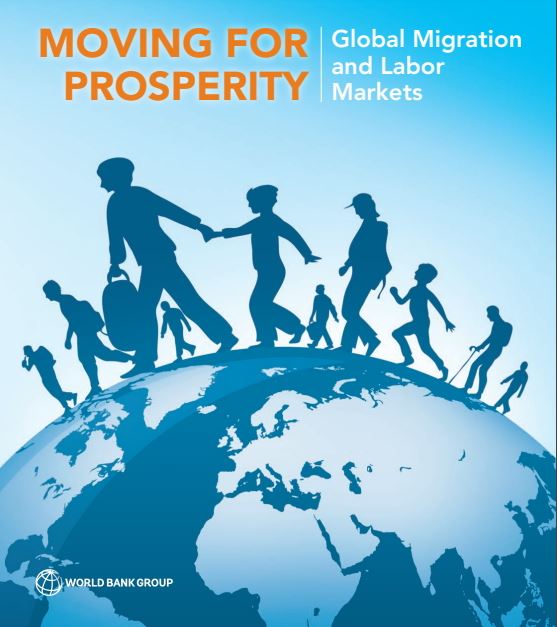 세계은행이 펴낸 정책보고서 「번영을 위한 이주 : 국제이주와 노동시장」 표지
세계은행이 펴낸 정책보고서 「번영을 위한 이주 : 국제이주와 노동시장」 표지
국제이주 패턴 : 규모
오늘의 언론 헤드라인은 우리가 엄청난 규모의 글로벌 이민 위기에 직면해 있다는 인상을 준다. 국제 무역과 투자 흐름이 세계 경제의 전례 없는 통합으로 이어졌음에도 불구하고 세계 인구에서 이민자가 차지하는 비율은 2차 세계 대전 이후 약 3%로 정체돼 있다. 2015년 기준으로 세계에는 2억4천만 명을 약간 넘는 이민자가 있다(그림 O.1 참조). 이민자 수는 제2차 세계 대전 이후 기간 증가했지만 세계 인구 증가와 같은 속도를 유지하는 정도에 불과하다.
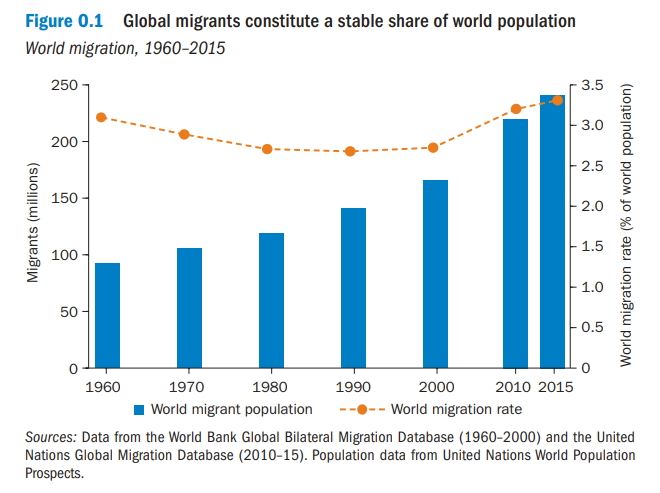 그림 0.1
그림 0.1
현재 언론 헤드라인에서 "난민"은 빈도 면에서 "이민자"를 능가하는 유일한 단어일 것이다. 시리아 아랍 공화국의 내전은 난민의 곤경에 대한 새로운 관심을 불러일으켰고, 자료에 따르면 현재 총 난민 수는 20년 만에 최고치를 기록했다. 그들의 총 숫자가 크게 변동했음에도 불구하고 난민은 전체 이민자의 10% 이상을 차지하는 경우가 거의 없다(그림 O.2 참조).
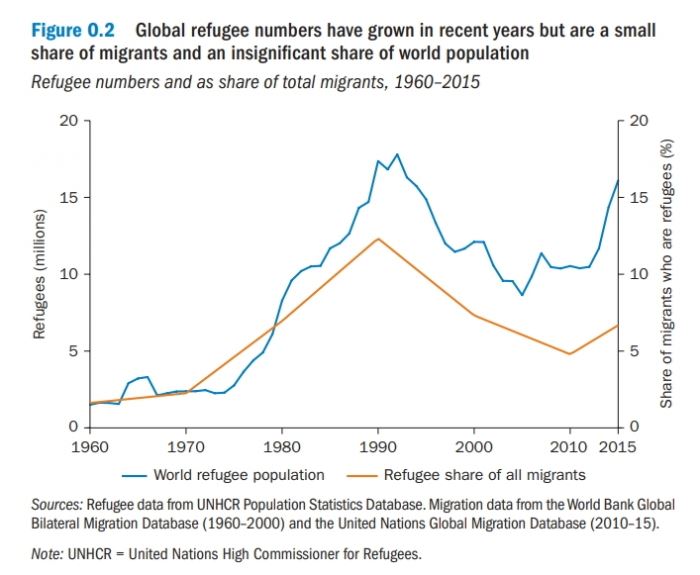 그림 0.2
그림 0.2
2015년에 약 1,500만 명의 난민이 있었고, 이는 2004년보다 약 50% 증가한 수치이며 1995년 이후 가장 높은 수치이다. 그럼에도 불구하고 난민의 비율은 전체 이민자의 약 7%, 세계 인구의 약 0.2%에 불과하다. 달리 말하면, 이스탄불, 로스앤젤레스 또는 모스크바와 같은 크기의 도시에 전 세계의 모든 난민을 수용할 수 있다.
국제이주 패턴 : 집중
글로벌 이주와 난민 흐름을 형성하는 경제력은 이민자들이 소수의 부유한 목적지 국가에 점점 더 집중되는 상황을 초래했다. 전 세계 이민자의 3분의 2는 북아메리카, 서유럽, 동유럽, 중동과 북아프리카의 고소득 국가에 거주한다(그림 O.3 참조). 1970년대 이후 대부분의 지역에서 이민자 점유율이 급격히 증가했다. 대조적으로, 동아시아, 라틴 아메리카와 카리브해, 그리고 사하라 이남 아프리카는 특히 지역 인구에 비해 세계 이민에서 차지하는 비중이 작은 것으로 유명하다. 이 지역들은 세계 인구의 45%가 살고 있지만 세계 이민자의 15%만이 거주하고 있다.
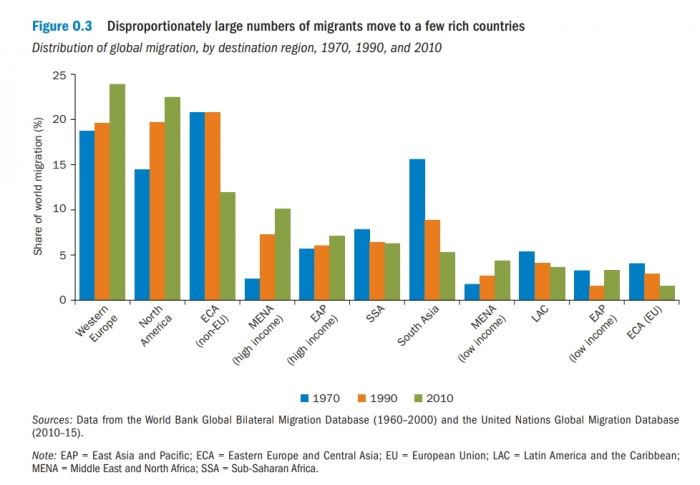 그림 0.3
그림 0.3
이러한 패턴은 소스와 대상국가에 있어 이민의 집중이라는 측면에서 무엇을 의미하는가? 그림 O.4는 이 질문에 답한다. 이것은 이민자 인구 규모에 따라 순위가 매겨진 목적지 및 원산지 국가별 이민자 누적 분포를 표시한다. 실선으로 묘사된 이민은 상위 10개 목적지 국가 내에 고도로 집중되어 있다: 그들은 전 세계 모든 이민자의 약 60%를 수용하고 있다. 11위부터 20위까지의 다음 10개 주요 목적지 국가들은 이민자의 약 15%를 가지고 있으며, 그 비율은 꾸준히 감소하고 있다. 이 패턴은 1970년부터 2010년까지 이민이 더 많이 또는 덜 집중되지 않는 등 시간이 지남에 따라 상대적으로 안정되어 왔다. 대조적으로, 점선으로 묘사되는 이민은 덜 집중되어 있고 시간이 지남에 따라 훨씬 더 분산되어 있다. 2010년까지 상위 10개 원산지 국가는 전체 이민의 40% 미만을 차지했는데, 이는 1970년의 55%에서 감소한 것이다.
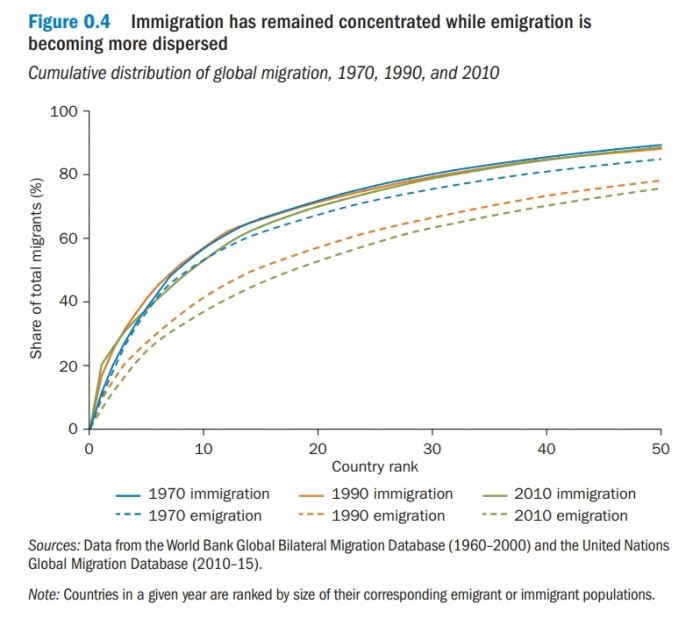 그림 0.4
그림 0.4
난민 유입은 훨씬 더 집중되어 있다. 2015년, 5개의 원천 국가가 전체 난민 중 55%를 차지했고, 5개의 목적지 국가가 전체 난민 중 40%를 수용했다. 경제 이민자들과 달리, 80%가 넘는 대부분의 난민들은 개발도상국에 살고 있다. 그림 O.5는 2015년 5대 위기 동안 다른 목적지에 걸친 난민 분포를 보여준다. 제시된 사례의 경우, 전체 난민과 망명 신청자의 87% 이상이 이웃 국가에 거주하고 있으며, 서유럽에 거주하는 비율은 8%에 불과하며, 미국에 거주하는 비율은 0.2% 미만이다. 그 결과 소수의 부유한 국가에서 이민자들이 크고 증가하는 인구 비율을 차지하지만, 난민 흐름의 집중은 소수의 가난한 국가들이 매우 큰 유입을 경험하는 결과를 낳는다.
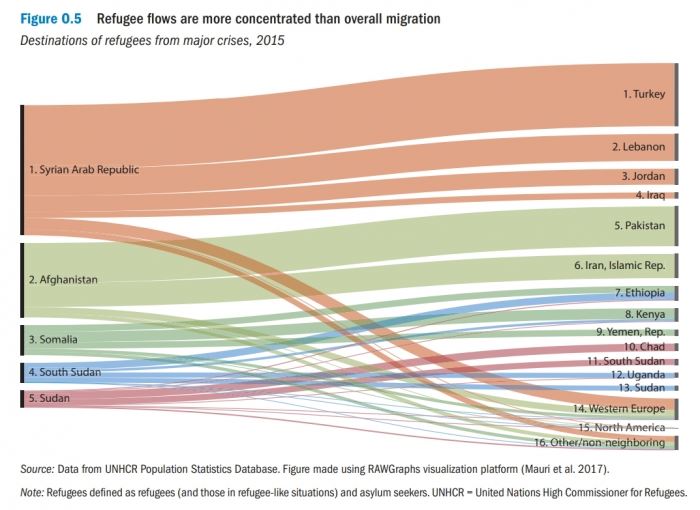 그림 0.5
그림 0.5
이러한 높은 이민 집중은 목적지 국가의 인구와 노동 시장에 중요한 영향을 미친다. 한편으로는, 집중력은 정확히 우리가 이민과 같은 경제적 재분배와 조정 메커니즘에서 기대하는 결과이다. 서로 다른 두 노동 시장에서 동일한 유형의 노동자에 대한 임금 격차가 클 때, 우리는 임금이 균등해질 때까지 크고 집중된 흐름을 관찰한다. 많은 면에서, 이것은 판매자들이 가격 차이를 이용할 때 시장을 가로지르는 다른 경제적 흐름과 다르지 않다. 이 조정 과정은 앞서 논의한 생산성 향상, 임금 인상 및 빈곤 감소를 산출한다. 즉, 경제 발전과 시장 힘이 일치한다.
한편, 미충족 수요를 충족시키기 위해 시장의 힘이 서두르면서 특정 목적지 국가, 경제 부문, 직업 및 지역에 이민자가 집중되는 것도 지역 인구의 경제적 문제와 문화적 불안의 주요 원인이다. 이것은 특히 쉽게 대체할 수 있는 기술과 직업을 가진 국내 인구의 경우이다: 그들은 새로 도착한 이민자들과 노동 시장에서 경쟁해야 한다. 문제는 이러한 집중으로 인한 조정 및 전환 문제를 어떻게 해결할 것인가 하는 것이다.
The patterns of global migration : Scale
Today’s headlines create the impression that we are facing a global migration crisis of extraordinary proportions. However, immigrants’ share of the global population has been stable at about 3 percent since the end of the Second World War even though international trade and investment flows have led to an unprecedented integration of the world economy. As of 2015, there were slightly more than 240 million migrants in the world (see figure O.1). Their number has grown throughout the post–World War II period, but only at a rate that has kept an even pace with world population growth.
In current media headlines, “refugees” is probably the only word that surpasses “migrants” in terms of frequency. The civil war in the Syrian Arab Republic has brought renewed attention to the plight of refugees, and the data indicate that total refugee numbers are currently at a 20-year peak. Even though their total number has fluctuated widely, refugees have rarely accounted for more than 10 percent of all migrants (see figure O.2). There were about 15 million refugees1 in 2015, an increase of about 50 percent from 2004 and the highest level since 1995. Nevertheless, the share of refugees is only about 7 percent of all migrants and about 0.2 percent of the world population. To put it differently, we could fit all the world’s refugees in a city roughly the size of Istanbul, Los Angeles, or Moscow.
The patterns of global migration : Concentration
The economic forces that shape global migration and refugee flows have resulted in a situation where immigrants are increasingly concentrated in a few rich destination countries. Two-thirds of the world’s immigrants reside in North America, Western Europe, Eastern Europe, and high-income countries of the Middle East and North Africa (see figure O.3). The immigrant shares in most of those regions have increased rapidly since the 1970s. In contrast, East Asia, Latin America and the Caribbean, and Sub-Saharan Africa are notable for their smaller shares of global immigration, especially relative to their local populations. These regions are home to 45 percent of the global population yet host only 15 percent of global migrants.
What do these patterns imply in terms of the concentration of migration in the source and destination countries? Figure O.4 addresses this question. It presents the cumulative distribution of migrants across destination and origin countries, ranked by the size of the migrant populations. Immigration, depicted by the solid lines, is highly concentrated within the top 10 destination countries: they host about 60 percent of all immigrants in the world. The next 10 largest destination countries, ranked from 11th to 20th, have about 15 percent of the immigrants; and the ratio steadily declines. This pattern has been relatively stable over time, with immigration becoming neither more nor less concentrated from 1970 to 2010. In contrast, emigration, depicted by the dashed lines, is less concentrated and has become even more dispersed over time. By 2010, the top 10 origin countries represented less than 40 percent of total emigration, down from 55 percent in 1970.
Refugee flows are even more concentrated. In 2015, five source countries accounted for 55 percent of all refugees, and five destination countries hosted 40 percent of all refugees. Unlike economic migrants, most refugees, over 80 percent, reside in developing countries. Figure O.5 shows the distribution of refugees across different destinations for the five major crises in 2015. For the cases shown, over 87 percent of all refugees and asylum seekers reside in neighboring countries, only 8 percent are in Western Europe, and less than 0.2 percent are in the United States. The result is that, although immigrants account for a large and rising fraction of the population in a small number of wealthier countries, the concentration of refugee flows results in a few poorer countries experiencing very large influxes.
This high concentration of immigration has important implications for populations and labor markets in destination countries. On one hand, concentration is exactly the outcome we expect from an economic reallocation and adjustment mechanism like immigration. When there are large wage gaps for the same type of worker in two different labor markets, we observe a large and concentrated flow until wages are equalized. In many ways, this is no different from any other economic flow across markets when sellers take advantage of price differences. This adjustment process yields the productivity gains, wage increases, and poverty reduction discussed earlier. In other words, economic development and market forces are in alignment.
On the other hand, concentration of immigrants in certain destination countries, economic sectors, occupations, and regions as market forces rush to fulfill unmet demand is also the main cause of the economic problems and cultural anxieties of local populations. This is especially the case for those domestic populations who have easily substitutable skills and occupations: they must compete in the labor market with the newly arriving immigrants. The challenge is how to address the adjustment and transition problems caused by this concentration.
[※ World Bank. 2018. Moving for Prosperity: Global Migration and Labor Markets. Policy Research Report. Washington, DC: World Bank. doi:10.1596/978-1-4648-1281-1. License: Creative Commons Attribution CC BY 3.0 IGO
This translation was not created by The World Bank and should not be considered an official World Bank translation. The World Bank shall not be liable for any content or error in this translation.
This is an adaptation of an original work by The World Bank. Views and opinions expressed in the adaptation are the sole responsibility of the author or authors of the adaptation and are not endorsed by The World Bank.]
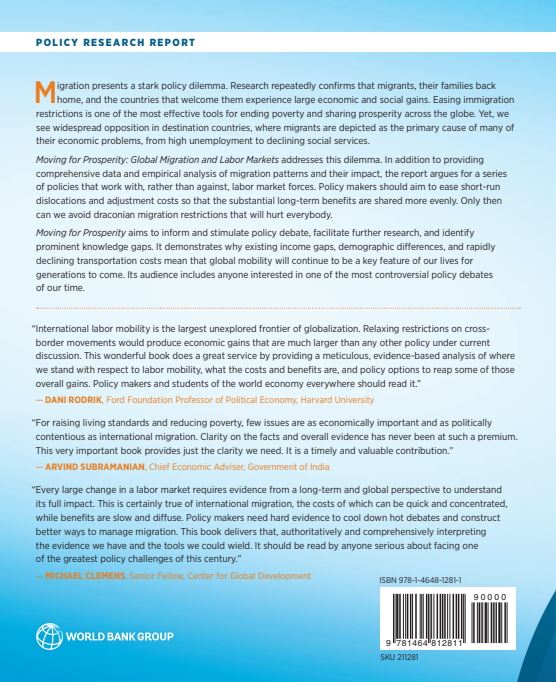 세계은행이 펴낸 정책보고서 「번영을 위한 이주 : 국제이주와 노동시장」 뒷표지
세계은행이 펴낸 정책보고서 「번영을 위한 이주 : 국제이주와 노동시장」 뒷표지
<pinepines@injurytime.kr>
저작권자 ⓒ 인저리타임, 무단 전재 및 재배포 금지